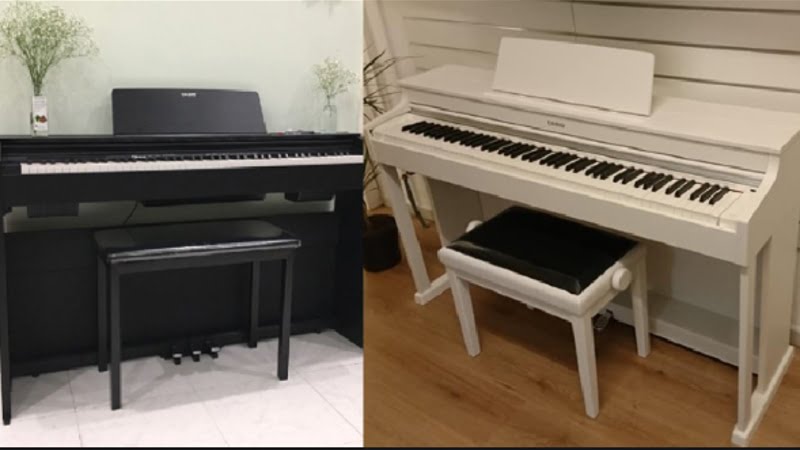These are two great pianos, but find out which one is better in this Casio PX-870 vs AP-470 comparison.
Console digital pianos are great alternatives to acoustic pianos, especially if you want an instrument in your home. And right now, two great digital pianos that you might want to consider are the Casio PX-870.
The PX-870 is a great piano for beginners and novice players. It offers decent sound quality, a basic set of piano tones, and various effects.
On the flip side, the Casio AP-470 is more expensive but comes with better sounds, a wider selection of voices, and a more premium look. That said, is the AP-470 really worth the extra investment?
The short answer? It is.
If you’re particular about sound quality and variety, the AP-470 is the more versatile overall option. But if you’re looking for the best piano for your needs, you’ve come to the right place.
In this Casio PX-870 vs AP-470 review, I’ll dive into all the details of these two pianos. That way, it will be easier for to figure out which one fits your home!
Casio PX-870 vs AP-470: Comparison Chart




Last update on 2025-04-16 / Affiliate links / Images from Amazon Product Advertising API
Casio PX-870 vs AP-470: A Head-to-Head Comparison
To find a definite winner between these two pianos, I compared them based on their tone, feel, and polyphony. And between the two, the Casio AP-470 edged out a narrow victory. Because it comes with a wider set of tones and a unique feature for capturing the sound of an open-lid acoustic piano, it won the comparison.
But as you can tell, the score was pretty close largely because the PX-870 comes with features that far exceed the expectations of its price range. Below, I’ll dive into the details of this comparison to make it much easier to find the piano that’s worth your time and money.
Tone
The winner: Casio AP-470
The one category where the Casio AP-470 was the clear and definite winner was in the tone. While the AP-470 and PX-870 both share the same tone generator, the AP-470 has a better sound library and has a unique feature you can use to generate an even more realistic piano tone.
So, even if it was a close fight, the AP-470 still won this category.
+Tone Generation
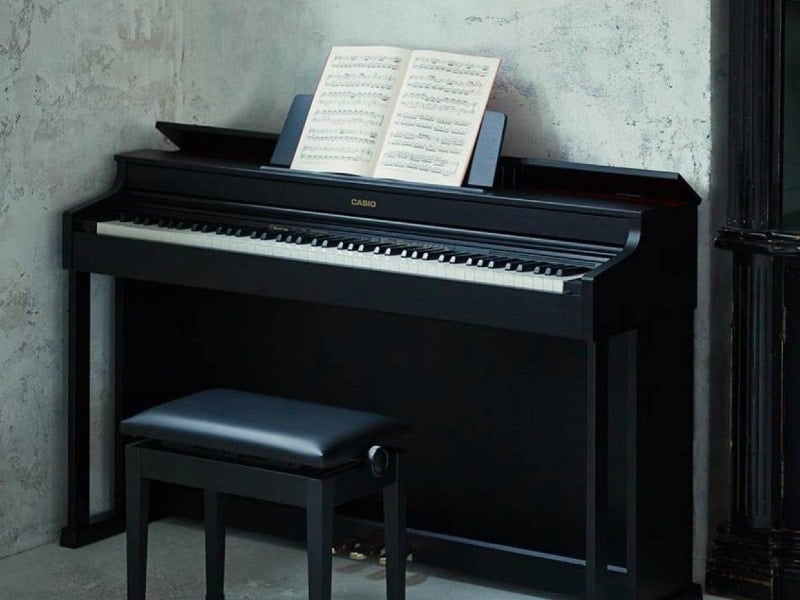
Both of these pianos excel in terms of tone generation. This is because they both use the Multi-Dimnesional Morphing AiR tone generator. This is a tone engine designed to mimic the way acoustic piano sounds travel through the air, producing a much more realistic tone.
And while the tone engine can’t beat the Yamaha CFX or Pure CF engines, it does a pretty good job of replicating the sound of an acoustic piano. The AP-470 and PX-870 are great picks for anyone that needs a realistic set of piano tones at home.
While the pianos share the same tone engine, the AP-470 sounds a bit more realistic because of the speaker system. But I’ll talk about that more a bit later.
+Sound Library
Another reason the AP-470 won the tone comparison was because of its sound library. These are both digital console pianos, so you shouldn’t expect the widest sound library. That said, the AP-470 and PX-870 come with a fair amount of tones, with each piano having 22 and 19 tones, respectively.
While these aren’t the widest sound libraries available, they are much more versatile than many other pianos in the same price range. On top of that, you get all the voices you’ll need as a pianist, such as acoustic pianos, electric pianos, organs, bass, strings, harpsichord, and more!
The AP-470 has a slightly better sound library and contains more acoustic piano sounds. While the piano sounds on the PX-870 are more than decent, having as many options as the AP-470 would have been a really nice feature.
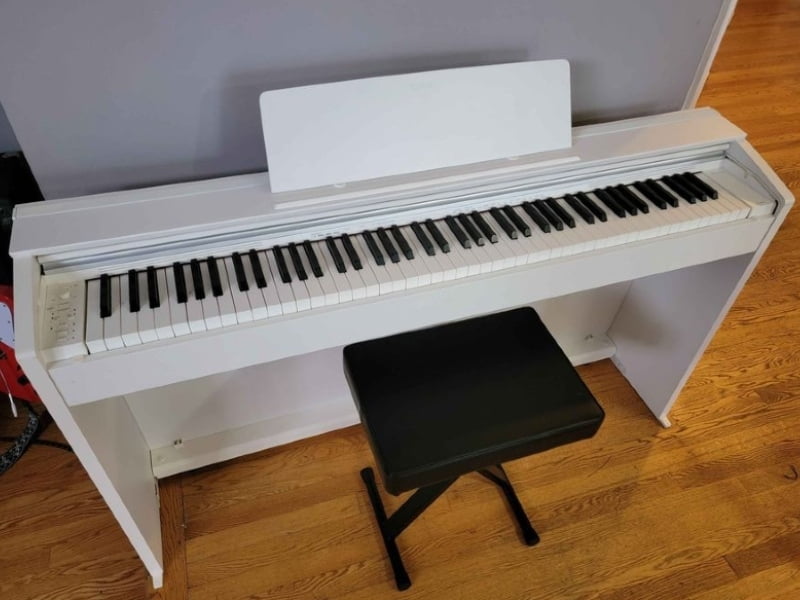
+Speakers
The last reason I think the Casio AP-470 offers better tones than the PX-870 is the speaker system.
Now, you might think that these pianos sound exactly the same because they have a similar speaker system. And while they do share the same speakers, the AP-470 comes with a lid that you can open and close.
When you open the lid, you get a brighter and clearer piano sound. But if you want a darker and warmer sound, you can close the lid for a different effect. You can do this same thing to adjust the tone on an acoustic piano, and it’s a really neat detail that you get with the AP-470.
You don’t get the same feature with the PX-870, which was a slight letdown. While you still get decent tones from the PX-870, you don’t have the same control over your tone as the AP-470.
Feel
The winner: Tie
The next comparison point is the feel. These are both digital console pianos, so it’s important that they feel like acoustic pianos. If a digital console piano doesn’t feel like an acoustic piano, it really isn’t worth getting.
However, the Casio PX-870 and AP-470 come with great hammer action systems and decent key texture, which is why they make for great home pianos for beginners, novices, and advanced pianists alike!
+Hammer Action
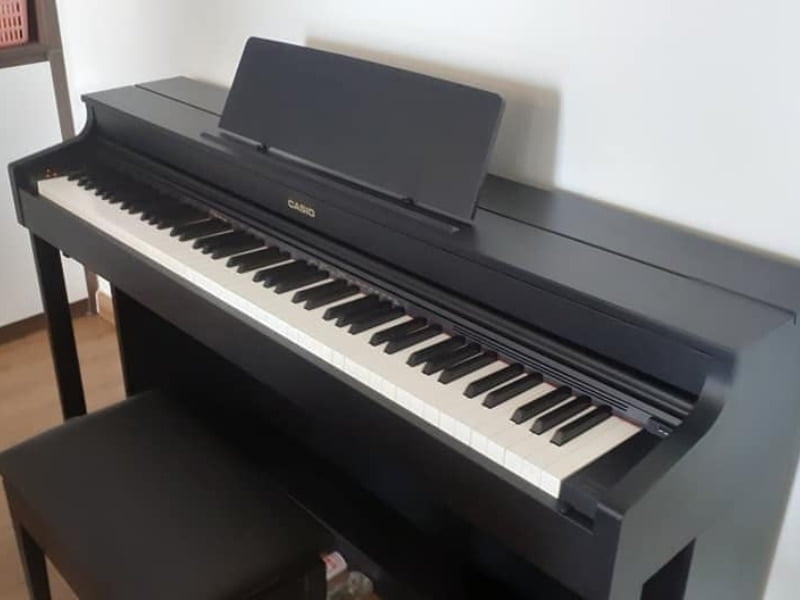
One thing you get with both of these pianos is tri-scaled hammer action II. This is an advanced hammer action that captures the subtle weight differences you get with an acoustic piano. Additionally, the weight on the keys doesn’t feel artificial, which is why these pianos feel really close to acoustic pianos.
Another detail this hammer action system offers is speed. When you play a note on an acoustic piano, there’s a slight delay between the time you press the key and the time you hit the note. Tri-scaled Hammer Action II captures that slight delay, which offers a more realistic sound and feel.
On top of that, both pianos have textured ebony and ivory keys. While the actual keys are made of plastic, they have a synthetic coating to mimic the texture of ebony and ivory keys. This is a great detail for Casio to add as one my major complaints with many digital pianos in this price range is the key texture.
That said, one thing I want to say about the AP-470’s feel is that it should have come with wooden keys. Since this is the more expensive model, it would have been nice to see real wooden keys on it. This isn’t a major complaint, but it’s worth noting when comparing these two pianos.
Polyphony
The winner: Tie
The last feature I compared was the polyphony. Basically, this refers to how many notes and samples the piano can play simultaneously.
So, since both these pianos come with 256-note polyphony, you can play up to 256-notes at a time. A piano only has 88 keys, so you might be wondering why you need this much polyphony in the first place.
Well, for example, if you hold the sustain pedal and continuously play notes, all the sounds that ring out count as samples. So, if you have low polyphony, these notes will fade out quickly. But with the PX-870 and AP-470, you can expect the notes to ring out a long time.
On top of that, this makes it easier to play with the dual mode, which layers various sounds on top of each other. This is great if you want to experiment with different sounds, and since these pianos have 256-note polyphony, you can easily handle this mode.
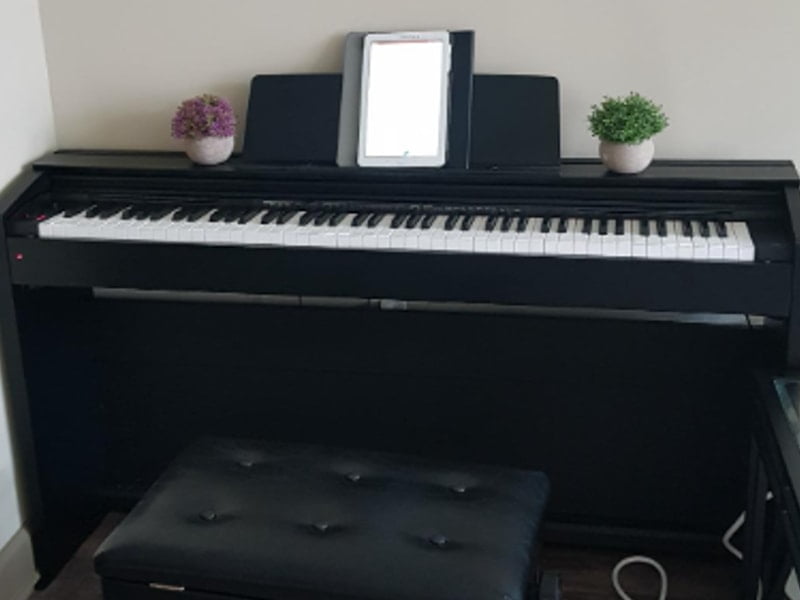
Casio PX-870 vs AP-470: The Similarities
These pianos aren’t that different. In fact, they share quite a few similarities. For example, these pianos have the same tone engine and hammer action system. This is why they sort of feel and sound the same, even if the AP-470 has a slight advantage due to the speaker system.
On top of that, both these pianos also offer split and dual modes. This gives you a lot of versatility in your playing and allows you to play different sounds simultaneously.
These pianos are both digital console pianos. This means that they are heavy and designed to stay in one place. So, if you’re looking for a piano to take on gigs, this isn’t he right option. But if you need a high-quyality digital piano at home for jamming and practice, these are great picks.
Quick Rundown of the Casio PX-870
- The AiR engine provides highly-accurate grand piano sounds with seamless dynamics for a remarkably expressive and powerful performance
- The PX-870 features a variety of 19 instrument Tones, with the ability to layer and split them as needed. Touch Response - 3 sensitivity levels, Off
- With a generous 256 notes of polyphony, you can rest assured that even the most complex performances will sound perfectly natural
- The Tri-Sensor Scaled Hammer Action II keyboard has an incredible feel and captures the dynamics of a performance with unparalleled speed and accuracy
- The powerful 40-watt, 4-speaker system is designed to envelop the listener, audience and room with rich, detailed sound
Last update on 2025-04-15 / Affiliate links / Images from Amazon Product Advertising API
Quick Rundown of the Casio AP-470
Last update on 2025-04-16 / Affiliate links / Images from Amazon Product Advertising API
Product Video
Related Articles to Casio Px 870
- Casio PX-870 vs PX-850: Finding the Best Privia Piano
- Casio PX-870 vs Casio AP-650: Which Casio Should You Get?
- Casio PX-870 Vs AP-270: Which Console Digital Piano Should You Get?
- Casio PX-870 Vs Yamaha YDP-163: Which Digital Piano Is The Better Option?
- Casio PX-870 Vs Yamaha YDP-143: A Look At Two Top Digital Console Pianos
- Casio PX-870 Vs Yamaha P-125: Should You Get A Portable Or Console Digital Piano?
- Casio PX-870 Vs Kawai KDP-110: The Best Digital Pianos In The Price Range?
- Casio PX-870 Vs Roland F140R: Which Is The Better Piano?
- Casio PX-870 Vs Roland FP-30: Which Piano Should You Choose?
- Casio PX-870 Vs 860: A Battle Of Two Privia Pianos
- Casio PX-870 Vs Roland RP102: Which Is The Better Console Digital Piano For Beginners?
- Casio PX-870 Vs PX-780: Which Casio Model Is Best For You?
- Casio PX-870 Vs Yamaha YDP-164: Which Is The Better Choice For Beginners?
- Casio PX-870 Vs Yamaha YDP-144: Which Is The Better Console Digital Piano?
- Casio PX-770 Vs 870: Which Casio Console Digital Piano Is Better?
References:
- Casio PX-870: https://www.casio-intl.com/asia/en/emi/products/px870/spec/
- Casio AP-470: https://www.casio.com/ph/electronic-musical-instruments/product.AP-470BK/
Lulacruza is an electronic folk duo operating at the junction of the hypermodern and the ancient. Our music weaves together hypnotic female singing, South American folk instruments and electronic processing, while channeling pulsating waves from the source of creation.
Lalucruza is also a community where you can connect with other music lovers to collaborate, exchange ideas and share knowledge. A platform for who wants to learns the basics of playing piano, guitar, drum masters’ technique, etc.. is the premise of our website.
